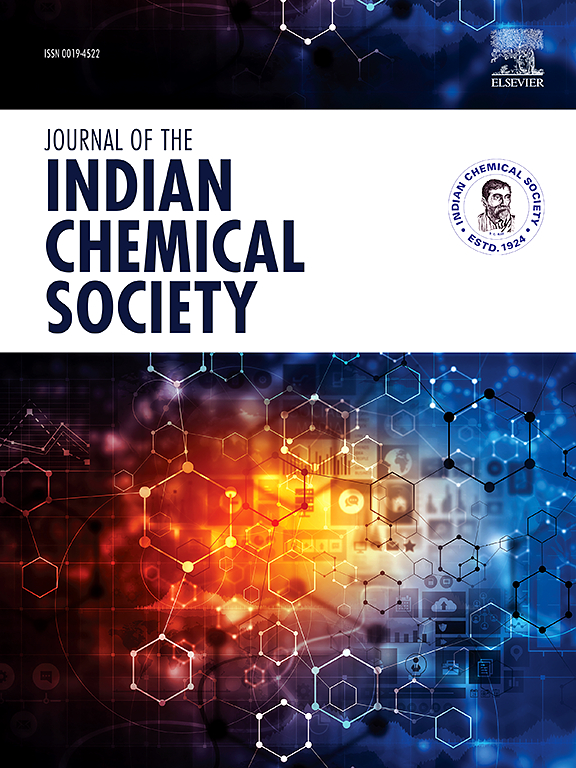C–H bond activation over chitosan based Fe(III) and Ni(II) catalysts
IF 3.2
4区 化学
Q2 CHEMISTRY, MULTIDISCIPLINARY
引用次数: 0
Abstract
Chitosan (Cs) supported heterogeneous catalysts of Fe(III) and Ni(II) is developed by the equimolar reaction of two schiff base ligands, L1 [Cs-HACP] and L2 [ANI-HACP] and Metal salts {where Metal = Fe(III) and Ni(II)}with chitosan. The L1 ligand is prepared by the reaction of chitosan (Cs) and ortho hydroxyl (HACP) acetophenone in methanol and L2 ligand is prepared by the condensation of aniline (ANI) and ortho hydroxyl acetophenone (HACP) in solvent free condition. The prepared catalysts {M-[Cs-L1-L2]Cl2} are characterized by different analytical techniques viz. scanning electron microscopy (SEM), energy dispersive X-ray analysis (EDX), powder X-ray diffraction (XRD), Thermogravimetric analysis (TGA), Fourier transform infrared (FTIR), Raman, UV-VIS-NIR, X-ray photoelectron spectroscopy (XPS) and computational studies. The catalytic behavior of newly synthesized catalysts are tested for the C–H activation using 70 % tert-butyl hydroperoxide (TBHP). The best results are obtained for tetralin oxidation. The order of catalytic reactivity of {M-[Cs-L1-L2]Cl2}catalyst is in decreasing order: {Fe(III)-[Cs-L1-L2]Cl2} > {Ni(II)-[Cs-L1-L2]Cl2}. The {Fe(III)-[Cs-L1-L2]Cl2} gives maximum conversion 81.99 % of tetralin with 84.50 % selectivity of tetralone (T-lone) and 6.47 % selectivity of tetralol (T-lol) after 5 h of reaction at 80 °C temperature. The chitosan based heterogeneous catalyst is easy to separate and recover. It can be recycled seven times.

壳聚糖基铁(III)和镍(II)催化剂上的 C-H 键活化
通过 L1 [Cs-HACP] 和 L2 [ANI-HACP] 两种席夫碱配体以及金属盐{其中金属 = Fe(III) 和 Ni(II)}与壳聚糖的等摩尔反应,开发出了壳聚糖(Cs)支持的 Fe(III) 和 Ni(II) 异构催化剂。L1 配体由壳聚糖(Cs)和邻羟基(HACP)苯乙酮在甲醇中反应制备,L2 配体由苯胺(ANI)和邻羟基苯乙酮(HACP)在无溶剂条件下缩合制备。所制备的催化剂{M-[Cs-L1-L2]Cl2}采用了不同的分析技术,即扫描电子显微镜(SEM)、能量色散 X 射线分析(EDX)、粉末 X 射线衍射(XRD)、热重分析(TGA)、傅立叶变换红外光谱(FTIR)、拉曼光谱、紫外-可见-近红外光谱、X 射线光电子能谱(XPS)和计算研究。使用 70% 的叔丁基过氧化氢 (TBHP) 测试了新合成催化剂的 C-H 活化催化性能。四氢萘氧化的结果最好。{M-[Cs-L1-L2]Cl2}催化剂的催化反应性依次递减:{铁(III)-[Cs-L1-L2]Cl2} > {镍(II)-[Cs-L1-L2]Cl2}。在 80 °C 温度下反应 5 小时后,{Fe(III)-[Cs-L1-L2]Cl2}的四氢萘转化率最高,达到 81.99%,四氢萘酮 (T-lone) 的选择性为 84.50%,四氢萘酚 (T-lol) 的选择性为 6.47%。壳聚糖基异相催化剂易于分离和回收。它可以循环使用七次。
本文章由计算机程序翻译,如有差异,请以英文原文为准。
求助全文
约1分钟内获得全文
求助全文
来源期刊
CiteScore
3.50
自引率
7.70%
发文量
492
审稿时长
3-8 weeks
期刊介绍:
The Journal of the Indian Chemical Society publishes original, fundamental, theorical, experimental research work of highest quality in all areas of chemistry, biochemistry, medicinal chemistry, electrochemistry, agrochemistry, chemical engineering and technology, food chemistry, environmental chemistry, etc.

 求助内容:
求助内容: 应助结果提醒方式:
应助结果提醒方式:


